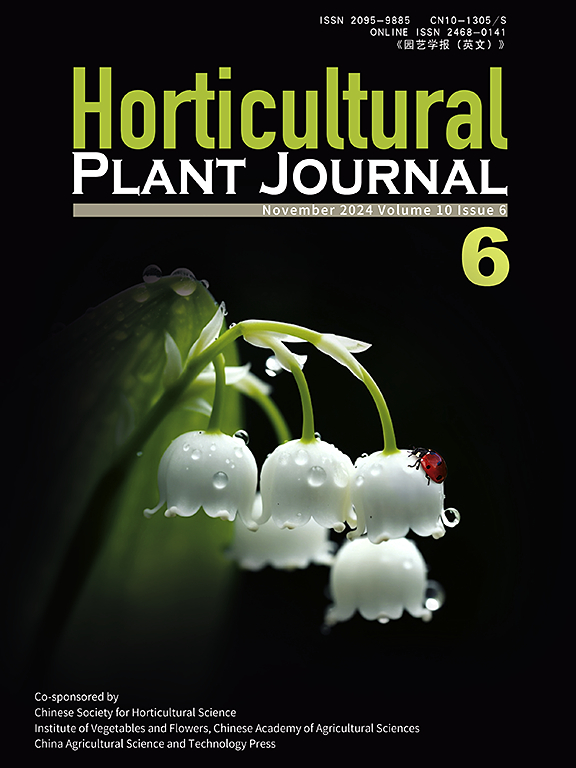苹果基因MdXTH15编码木葡聚糖内转移酶/水解酶,可以提高植物对干旱、盐和病原体胁迫的抗性
IF 6.2
1区 农林科学
Q1 HORTICULTURE
引用次数: 0
摘要
植物细胞最外层的保护层被称为细胞壁,它主要由纤维素、半纤维素和果胶组成。高等植物细胞壁中半纤维素的主要成分是木葡聚糖,它为细胞壁提供机械支撑,限制细胞生长。XTH基因家族成员通过编码具有糖基转移酶/水解酶活性的蛋白,介导木葡聚糖链的裂解和重排,从而参与植物细胞壁的重塑。植物可以通过改变细胞壁的结构和组成来增强对外界胁迫的适应能力。然而,关于苹果XTH基因家族的研究很少。在这里,我们成功地从苹果基因组中分离出MdXTH15,发现它含有一个高度保守的GH16-XET结构域。该基因在苹果茎中表达量最高,对外界非生物胁迫处理有响应。通过亚细胞定位分析发现该蛋白定位于质膜上。它的过表达增强了苹果和拟南芥的非生物胁迫和抗病性。此外,我们在细胞壁水平上阐明了抗逆性的分子机制,并为这一现象提供了新的视角。总的来说,我们的研究结果为提高苹果的抗逆性提供了一种新的途径。本文章由计算机程序翻译,如有差异,请以英文原文为准。
Apple gene MdXTH15, encoding endotransferase/hydrolase for xyloglucan, can improve plant resistance to drought, salt, and pathogen stresses
The outermost protective layer of plant cells is known as the cell wall, and it mostly comprises cellulose, hemicellulose, and pectin. The primary component of the hemicellulose in the cell wall of higher plants is xyloglucan, which provides the cell wall with mechanical support and restricts cell growth. XTH gene family members contribute to the remodeling of plant cell walls by encoding proteins with glycosyltransferase/hydrolase activity, which can mediate the cleavage and rearrangement of xyloglucan chains. Plants can enhance their resilience to external stress by modifying the structure and composition of the cell wall. However, few studies have been conducted on the XTH gene family in apples. Here, we successfully isolated MdXTH15 from the apple genome and found that it contained a highly conserved GH16-XET domain. The expression of this gene was highest in the stem of the apple, and it responded to external abiotic stress treatment. The protein was found to be localized to the plasma membrane by subcellular localization analysis. Its overexpression enhanced abiotic stress and pathogen resistance in both apple and Arabidopsis . Furthermore, we elucidated the molecular mechanisms underlying stress resistance at the cell wall level and provided a novel perspective on this phenomenon. Overall, our findings provide a novel approach for enhancing the stress resistance of apples.
求助全文
通过发布文献求助,成功后即可免费获取论文全文。
去求助
来源期刊

Horticultural Plant Journal
Environmental Science-Ecology
CiteScore
9.60
自引率
14.00%
发文量
293
审稿时长
33 weeks
期刊介绍:
Horticultural Plant Journal (HPJ) is an OPEN ACCESS international journal. HPJ publishes research related to all horticultural plants, including fruits, vegetables, ornamental plants, tea plants, and medicinal plants, etc. The journal covers all aspects of horticultural crop sciences, including germplasm resources, genetics and breeding, tillage and cultivation, physiology and biochemistry, ecology, genomics, biotechnology, plant protection, postharvest processing, etc. Article types include Original research papers, Reviews, and Short communications.
 求助内容:
求助内容: 应助结果提醒方式:
应助结果提醒方式:


